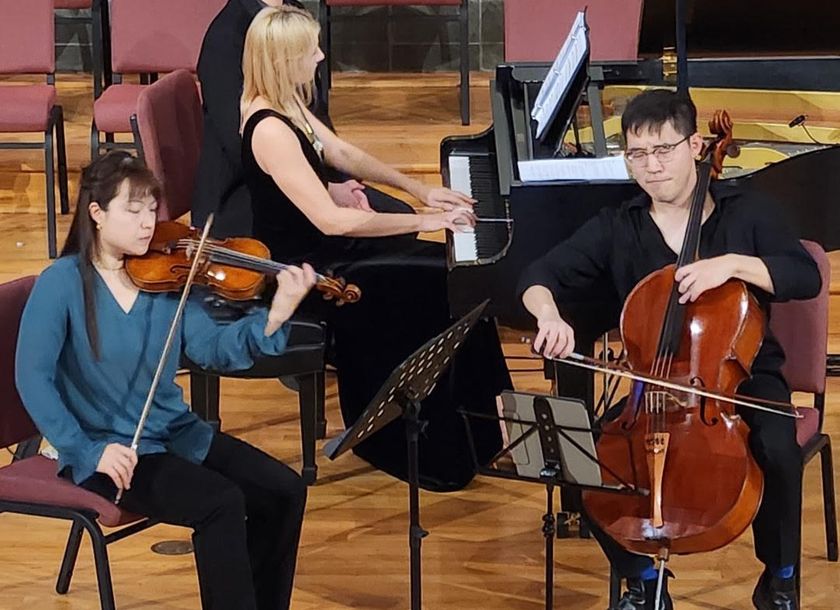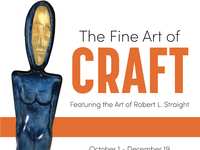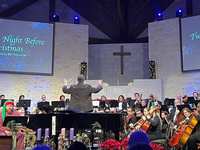- Sections :
- Crime & Public Safety
- Restaurants & Food
- Sports
- More
The Kingwood Methodist Concert Series: Cho, Chen, and Blagulyak; Amaze!!!

KINGWOOD, TX -- If you enjoy chamber music in an intimate setting, there are plenty of opportunities around the Houston region to partake in the practice. The Kingwood Methodist Concert Series is in its inaugural season, and promises great things with incredible musicians, all experts in their craft; playing amazing pieces to perfection in a wonderfully wooded sanctum that allows the sound to come at you from all angles. Artistic Director Dr. Olena Blagulyak, has a great ability to gather exceptional musicians and express their artistry to the local community. And music in a religious setting somehow has a power in itself, offering the concert goer a chance to find peace, inspiration, lifted spirits, and even a healing through the power of music. It’s an opportunity for the young and old to search out a gateway to a more profound connection to the arts, allowing for a more enjoyable cultural experience. Ms. Blagulyak invited renowned Houston Symphony violinist Annie Chen, and the massively awarded cellist Eunghee Cho, for the February 2nd event, with piano combinations for both the violin and cello, concluding with a finale of Rachmaninov including all three instruments.
Most know Maurice Ravel (1875-1937), through his most famous work, ‘Boléro,’ but his repertoire includes chamber music, dueling pianos, ballet, opera, song cycle, as well as piano pieces. His second violin sonata can be misleading seeing as his first work, written much earlier, was never published in his lifetime, only seeing the light of day in the 1970’s when it was found and published. Ravel’s ‘Violin Sonata No. 2,’ is typically played with a piano and violin in a three movement piece that can tell essentially different stories.
The first movement starts with a piano lead, and a delicate violin exhibiting a dark fairytale vibe. It’s stressful, and feels like a hurting that you wouldn’t wish visited upon a young and sweet damsel. There are fleeting moments of happiness, with hope and joy intermingling, leaving for a satisfying outlook. The offset echos of the violin and piano were much appreciated, entrancing. showing the teamwork that made for an excellent Allegretto. The non-traditional Second movement, Blues, starts with a right hand bow pizzicato, with an interesting variation of the technique with a quasi guitara sound, and sets an interesting theme, which the piano confiscates and possesses for a short while. It has a jazzy, big city feel, reminiscent of the American rhythms and harmonies emanating from the jazz and blues memories Ravel would have accumulated in Paris. It’s music perfectly set for a dimmed stage, in a way seductive, and the violin and piano balance off each other, as lovers do. It reminds of smoke filled rooms, of quiet talk between couples or small groups. The multiple pizzicato episodes are morse code for the heart, and the stresses that can be produced from intense relationships. Listeners can learn a lot from this movement, and even those not accustomed to jazz can be eased into learning about some of its qualities. The third movement, Perpetuum Mobile, again piano led, is the shortest segment of the piece. A few echos, pizzicato, more childish echos, before a flurry of notes, Bach-ish in racehorsing intent I would say. By far it is the quickest of the movements, a reminder of François Schubert’s ‘The Bee,’ but for sure no glissandos or portamentos allowed, sautillé actually for the bow technique, if memory serves; which is very entertaining; and if it were a recipe, Ravel threw in a dash of George Gershwin’s piano ‘Rhapsody in Blue,’ since it would have been the last ingredient, keeping it Kosher. The colors of the instruments present sounds not normally heard, but instill interest in its exploration, and we must offer gratitude to Ravel, for taking the chance to experiment and record for posterity music that is 100 years old with unexpected rhythms that are still unique today. Chen’s command of the violin was stunning, along with Blagulyak’s accompaniment on the piano, which really shined throughout the entire piece, but was amazing in the last movement.
The Argentinian composer Astor Piazzolla (1921-1992), was famed the world over for his tango compositions. In his piece ‘Le Grand Tango,’ written for cello and piano in the early 1980’s, and published in France, Piazzolla exposed a new angle to the craft, combining traditional tango rhythms with jazz-inspired beats normally left unaccented. Combined in a single movement, the tango has three sections with each its own distinct theme.
It is a combined marcato start that has a rigid feel to it, with emphasis, and it sorta reminded me of the Saturday Night Live counter-culture skit, ‘Sprockets.’ music intro. It also made me want to dance contortedly for a few seconds, in Tempo di tango. There is a revolutionary feel to it; the strongly accented tango rhythms dominate, like living on the edge, as with war, some loves, and the chances of living an eternal life, or of a certain death. Being an optimist, let’s choose life.
My father influenced me as a young kid with Fats Domino, and as an adult, he’d ask me to digitize some of his Spanish language disks, and in taking him to his cancer treatments, the music of Marco Antonio Solis, just sitting next to my father in listening to the artist brought us closer. And for a good portion of my life, we were estranged, not necessarily from distance, but from attitude. And even with my lack of command of the Spanish language. I got the jist of what was being sung. And even today I find myself longing for a song by Marco Antonio, in remembrance of my father. I apologise for the digression, but I have an affinity for Latin American music, and I’m glad it’s fatherly influenced. Whether it’s Marco Antonio Solis, or Piazzolla, the music has a soul; there’s a fire there that makes it unique, and thanks to Astor with Le Grand Tango he brings the fire and soul together that make for a great piece, not father and son focused, but it brings out feelings that enable sons to become fathers, and that is what life is about.
The second section of Le Grand Tango, brings out a tango, or dance if you will, of the cello and piano. There is a certain intimacy involved, as if the lights have dipped, and things are done that lovers do to show appreciation for one another, which with luck will last, till its time to depart the bounds of this Earth. About half-way through it picks up, then dips again, free and singing, until the lovely flourish reaches its end. The final section, right off the bat, offers pure energy. The rest periods of first and second sections, now allows for the release of pent up energy for love, dance, and enjoyment of life. The giocoso tempo allows for the comedic side of the mind to take over and express to everyone that you feel great, and you want to share your joy. And as the piece charges to its conclusion the cello does double duty in its double-stops and glissandos. I believe Piazzolla’s aim was to express a great warmth of the feelings of human emotion, taking from it a certain cadence that allows us to maintain a confident footing in life, which is so important in the tango. I cannot say enough for the vigor of Eunghee Cho, and the precision of his play in the piece. It, for the lack of better word, was breathtaking. His CV, for being a young man, is very impressive. And I’m not comparing him to Yo-Yo Ma, yet. But I’d like to see him with Mr. James Dick at Round Top reenacting the Yo-Yo Ma Porch Concert at Festival Hill from the 1970’s. That’d be a sight to see, and if anyone at The Round Top Festival Institute can make this happen (please let me know). Ms. Blagulyak’s piano play was nothing short of sensational, and I’ve seen her play very difficult pieces to perfection.
Following the break, the combination of Annie, Eunghee, and Olena playing Sergei’s Rachmaninov’s ‘Trio élégiaque No. 2 in D minor, op. 9’, finally gave Blagulyak a piano solo, which was welcomed with multiple opportunities. It’s incredible a young Sergei, barely out of his teens, wrote this amazing piece, in just seven weeks, thankfully, before he started drinking in his mid-20’s. The German based ‘Rachmaninoff Vodka,’ did not pass his lips. The spirit might be named after him, but its low budget.
The trio is a Rachmaninov’s memorial piece to Pyotr Ilyich Tchaikovsky, and it has its funerary moments, intermingled with the successes of the great master's achievements. It’s a long piece, written in three movements, and the intensity of Chen’s violin and Cho’s cello was a sight to see. The piano solos feature some of the masterly difficult play I’m used to hearing from Ms. Blagulyak, and are beautiful and dramatic at the same time. The rest periods are equally intense, built in quiet time of low tones to remember loss, and celebrate their life, the purpose of the piece, and a fitting vehicle for tributes to the great composer, and even the great people in our own lives; Tchaikovsky or not.
It was a memorable evening. To see great artists working their craft to heights that most will never hear. It was a privilege to see the performance and receive the wondrous sounds. Music is the life’s blood of Annie Chen, Eunghee Cho, and Olena Blagulyak; who we owe a special thanks to her for organizing the event, and allowing the violinist and cellist to take center stage, entertain, not only sharing their abilities but their passion in making music for remembrance.
The Kingwood Methodist Concert Series: kingwoodmethodist.org/music
Next concert is 3/22/25
Ruben can be reached at: ruben@montgomerycountynews.net





